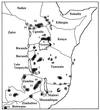History of sleeping sickness in East Africa
- PMID: 9880477
- PMCID: PMC88909
- DOI: 10.1128/CMR.12.1.112
History of sleeping sickness in East Africa
Abstract
The history of human sleeping sickness in East Africa is characterized by the appearance of disease epidemics interspersed by long periods of endemicity. Despite the presence of the tsetse fly in large areas of East Africa, these epidemics tend to occur multiply in specific regions or foci rather than spreading over vast areas. Many theories have been proposed to explain this phenomenon, but recent molecular approaches and detailed analyses of epidemics have highlighted the stability of human-infective trypanosome strains within these foci. The new molecular data, taken alongside the history and biology of human sleeping sickness, are beginning to highlight the important factors involved in the generation of epidemics. Specific, human-infective trypanosome strains may be associated with each focus, which, in the presence of the right conditions, can be responsible for the generation of an epidemic. Changes in agricultural practice, favoring the presence of tsetse flies, and the important contribution of domestic animals as a reservoir for the parasite are key factors in the maintenance of such epidemics. This review examines the contribution of molecular and genetic data to our understanding of the epidemiology and history of human sleeping sickness in East Africa.
Figures




References
-
- Abaru D E. Sleeping sickness in Busoga, Uganda, 1976–1983. Trop Med Parasitol. 1985;36:72–76. - PubMed
-
- Anonymous. Sterile sex conquers sleeping sickness. New Sci. 1997;156:12.
-
- Apted F I C. The epidemiology of Rhodesian sleeping sickness. In: Mulligan H W, editor. The African trypanosomiases. London, United Kingdom: George Allen and Unwin; 1970. pp. 645–660.
-
- Apted F I C, Ormerod W E, Smyly D P, Stronach B W. A comparative study of the epidemiology of endemic rhodesian sleeping sickness in different parts of Africa. J Trop Med Hyg. 1963;66:1–16. - PubMed
Publication types
MeSH terms
Grants and funding
LinkOut - more resources
Full Text Sources

